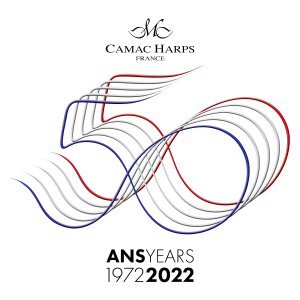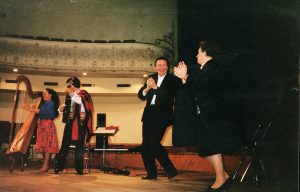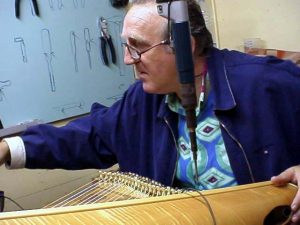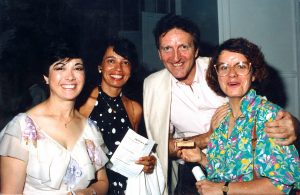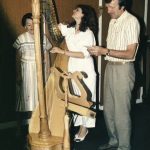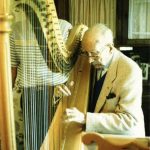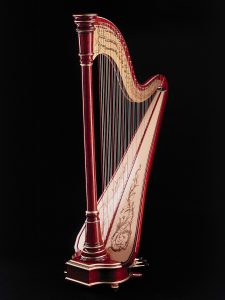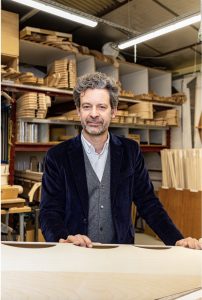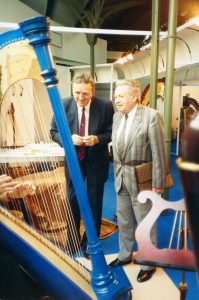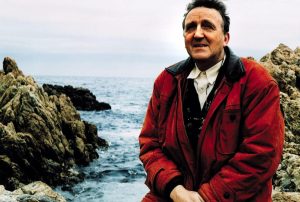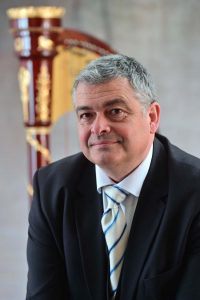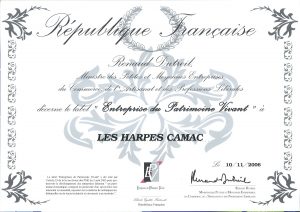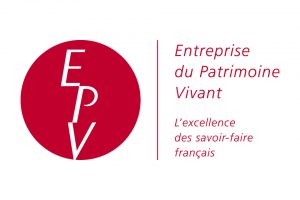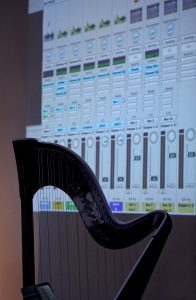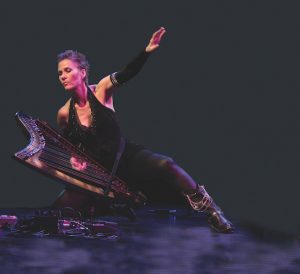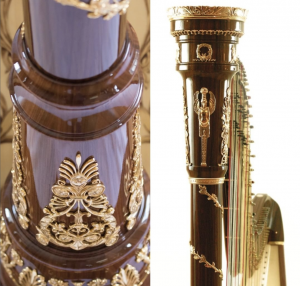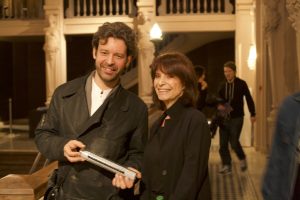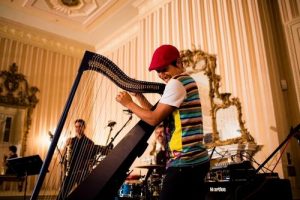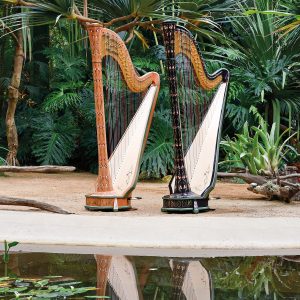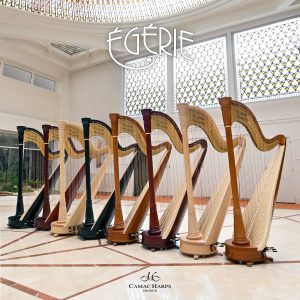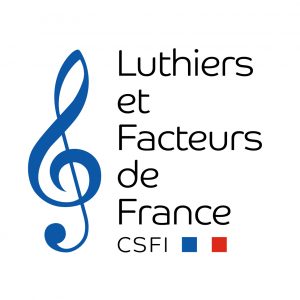Camac Harps: company history
2022 is Camac Harps’ 50th anniversary year! We have been making harps since 1972, proud to serve music and musicians. The following history is intended to provide an overview for organologists and other researchers, or for the simply curious. Do contact [email protected] if you have further questions; journalists can also consult our press space.
Camac timeline
1972: Gérard and Joël Garnier found the Camac Society in Mouzeil
Camac Harps has always been based in the hamlet of Mouzeil, near Nantes in Brittany, France. The brothers Gérard and Joël Garnier founded the company in the midst of a strong global folk revival, which had reached France from the USA via Great Britain. Part of this was a craze for world music, and Camac actually began life making American Indian flutes. Our company name is inspired by Pachacamac, the Inca god of creation. “Camac” means “Creation” in the Quechuan language.
Parallel to this, the lever harp was becoming more and more popular in both Brittany and Paris. Brittany, a Celtic land, was regularly visited by Irish, Scottish, Welsh and Cornish harpists.
From the second half of the twentieth century, Parisian-Breton diaspora also revived the Celtic harp. They adopted it as a symbol of resistance against the centralising French State, drawing a parallel with the Irish harpers who had to burn their instruments when the English invaded.
Hence, the market demand for harps in France was rapidly approaching one requiring domestic production.
Camac’s first harp
Recognising the business opportunity, the Garnier brothers had quickly diversified their folk instrument range into hurdy gurdys, Vosges spinets, Scottish bagpipes, dulcimers, bombardes and Breton bagpipes. On the request of some of their clients, they began to explore the lever harp. They initially imported them from Japan.
Seeing this import situation as a “challenge [they] wanted to take up”, Gérard and Joël Garnier launched a Bardic harp with a rectangular soundbox. Devised together with Jacques Rousseau and André Glemin, it was smaller and more portable than the standard 34- or 38-string harp, and directly inspired by the famous “Brian Born” Irish harp (now preserved at Trinity College Dublin). This period coincided with the rise of the Celtic rock star Alan Stivell: his success fuelled harp orders, particularly in the kit form very popular at this time.
Joël Garnier, however, was under no illusions about his first instrument. “It was not ugly, but its reliability left much to be desired. I made it my business to meet with as many harpists as possible. Little by little, I discovered the harp, its music, the harpists themselves, and I came genuinely to love them.”
1976: the Morgane and the Mélusine
These many years of research and exchanges with harpists led to the development of the Morgane. This lever harp with 34 strings was developed with the advisory help of Mariannig Larc’hantec, one of the pioneering teachers of the instrument in Brittany and, like so many, Telenn Bleimor-trained. Read more about Mariannig on the Camac blog.
The Mélusine was soon added to the burgeoning range of Celtic harps, with two more bass strings than the Morgane had. The Mélusine, in turn, was soon followed by the Brocéliande (a version on a raised stand which is no longer made). In the space of these few years, the small artisanal factory captured over 95% of the Celtic harp market in Brittany.
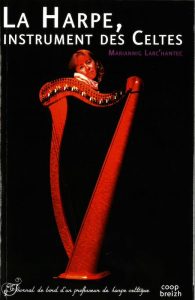
Read more on the Camac blog
1984: Joël Garnier and Kristen Noguès present the electroharp prototype at the Edinburgh International Harp Festival
The 1970s folk rock wave created a new need among harpists – amplification. Alan Stivell was one of the first, performing to audiences of thousands in the world’s largest stadiums. In this context, external microphones are useless. They pick up the rest of the band as well as the harp, and feedback is a major problem.
Joël Garnier decided to take on the challenge of harp amplification. Drawing on techniques developed by some guitar makers, he conceived a solid body harp with no soundbox at all. He placed a piezoelectric pickup on each string, and the first electric harp was born. It was to become an unstoppable success.
Camac’s resulting, 36-string Electroharp was presented by Joël Garnier and Kristen Noguès at the 1984 Edinburgh International Harp Festival, followed by the 1985 World Harp Congress in Jerusalem. It was used by Alan Stivell for his disc “Harpes du Nouvel Age”, and also rapidly adopted by the Scottish harpists Patsy Seddon and Mary MacMaster.
The interest and support shown by modern trad, pop, jazz and blues harpists has contributed immeasurably to the development of the Camac electric harp. It seems fitting that our electroharp prototype is now in the National Museum of Scotland.
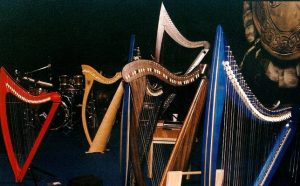
“Three Days”, by Mary Macmaster, was commissioned by the Celtic Connections Festival Glasgow (2002), to celebrate the life of Joël Garnier and his contribution to the electric harp. Here are all the harps used for the recording of the work, played by Mary, Kristen Noguès, Patsy Seddon, Corrina Hewat and Maeve Gilchrist.
1985: Memory Harp
By the 1980s, Camac was receiving more and more requests from harpists for pedal harps. Joël Garnier wasted no time in taking up this new challenge.
At this point, it can be noted that Joël Garnier was an electrical engineer. Musical instrument historians will recognise the connection between this type of background and a strong propensity to radical technological innovation. In 1981, observing that “the manufacture of the concert harp is rather archaic and could certainly be evolved”, he decided to build a computer-powered instrument.
A classical pedal harp changes semitones by means of seven pedals located in the box at the base of the harp. With his ‘Memory Harp’, Joël Garnier had the idea of replacing the conventional mechanism with a hydraulic system connected to a computer. Instead of pedal discs, the harp was equipped with miniaturised hydraulic clamps, while electrical sensors detected the movements of the pedals. Finally, the computer allowed the harpist to program all the pedal changes in a piece in advance, so the seven pedals could be moved simultaneously and in all directions. There was even a playing mode specially designed for improvisation!
The Memory Harp caused a sensation at the World Harp Congress in Jerusalem. Yet all instrument makers, no matter how inspired, must calibrate their vision with the needs of musicians. This “Concorde of the harp” (as Jakez François calls the Memory Harp) was brilliant, but unworkable. It required radical changes in harpists’ performing technique, it was exorbitantly expensive, and not all its technology was reliable. Like Concorde, it has been retired. It is now on display in the Instruments of the Twentieth Century section at the Musée de la Musique in Paris.
1987: Camac’s first pedal harps launched in Vienna
Joël Garnier presented Camac’s first acoustic pedal harps at the 1987 World Harp Congress in Vienna. This was a proud moment: the first pedal harps made in France since the time of Érard!
Of much more traditional build than the Memory Harp, these pedal harps had just one innovation: a metal core to the column. This is an idea taken from Pleyel, and is a principle Camac still follows. Today, the core is carbon fibre, lighter and even more stable than metal, and clad with wood.
1988: Jakez François joins Camac Harps
Joël Garnier had a unique, abundant imagination, but he was not a musician and did not play the harp. He felt the need to integrate these artistic skills into his team. It was in this context that Jakez François, a harpist by training, joined the company as a harp technician with the aim of expanding the instruments’ improvements. It was an ideal partnership: Joël Garnier concentrated his work on manufacturing and technical innovations; Jakez François was more interested in musical and artistic considerations.
1990: Blue Harp launched in Paris
The success of the Camac electroharp inspired harpists to ask Joël Garnier for a pedal electric harp. The electric lever harp is a solid-body harp without a soundboard, which is easier to amplify cleanly. For the pedal harp, Garnier’s vision was ambitious: he wanted to combine the natural acoustic harp sound with the power and precision of an electronic one.
On installing the electroharp’s piezo pickup system in a pedal harp soundbox, the results surpassed all expectations. The final version was presented at the 1990 World Harp Congress in Paris.
Its famous electric blue colour was chosen to match Jakez’s glasses of the time…which he wore to demonstrate the harp at the Congress. It is for this simple reason that Camac electric harps have been called Blue Harps ever since, although of course they can be made in other finishes. Harpists DeWayne Fulton and Harvi Griffin could not resist the temptation to try the new harp for their jazz/pop concerts at the WHC – a moment that remains etched in the memory of all those privileged enough to have been there. The legend of the blue harp was born!
Those interested in the early days of the blue harp can also explore the work of Elisabeth Valletti, including some previously unreleased recordings now available since 2020.
1996: “New Generation” Concert Harps launched in Tacoma
Together, Joël Garnier and Jakez François reconceived the traditional harp build in order to resolve some common issues in the mechanism, maintenance, and how ergonomic it was to play. The result was the “New Generation” Clio, Athena (discontinued in 2020) and Atlantide Prestige. Their goal was to deliver a fine, round and clear sound, coupled with the greatest ease of playing. They had also worked on a particularly accurate, quiet and easy-to-regulate mechanism.
In 1999, these harps were joined by the New Generation Concert Grands: the Trianon and Oriane, still part of our Concert Grand range today. They were launched at the World Harp Congress in Prague.
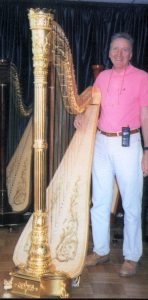
Joël Garnier with the first Oriane.
11 September 2000: Joël Garnier dies. Jakez François became President of Camac Harps.
Having previously assumed the general direction of Camac Harps, Jakez François became President of the company on Joël Garnier’s death. Please see here for Jakez’s tribute to Joël.
2000: Éric Piron joins Camac Harps
With a background in industry and marketing, Eric Piron had known of Camac Harps for many years. Joël Garnier had, in fact, been Eric’s wife’s stepfather. This family connection inspired Joël to invite Eric Piron to join the company, co-managing production with him.
Following Joël Garnier’s death, Eric’s commercial and marketing experience came to define the diffusion of the company’s savoir-faire. Today he is a partner, and the CEO of Camac Harps.
2006: Camac Harps are awarded the title “Entreprise du patrimoine vivante” from the French Government
The ‘Company of Living Heritage’ award is a mark of recognition from the French Government. It is for companies who have achieved excellence in the fields of craftsmanship and manufacture, and who thereby underpin the economic and cultural identity of France.
Since first being awarded the label in 2006, it has been constantly renewed. Camac Harps have now been an EPV for more than fifteen years.
2009: Launch of the Camac MIDI harp, London
Jakez François had dreamed of a fully MIDI harp for twenty-five years. While MIDI technology itself had existed since the 1980s, its implementation on a pedal harp was a radical innovation full of technological challenges. Jakez’s dream finally became reality on April 1, 2009, during the Trinity Harp Days in London.
For the launch presentation, Jakez was assisted by Dominic Murcott, head of music technology and composition at Trinity Laban College of Music and Dance.
Dominic has been one of several key actors in the MIDI harp’s artistic development: he was also instrumental in developing the patches for Graham Fitkin’s No Doubt: Concerto for MIDI Harp and Orchestra. This was commissioned by Sioned Williams following the MIDI harp’s London presentation, and premiered by Sioned and the BBC Symphony Orchestra conducted by Andrew Litton on January 26, 2011.
2010: launch of DHC electric harp
The ultralight DHC electric harp took the electroharp to a new level via our collaboration with Deborah Henson-Conant. Weighing just 5kg, it is a “wearable” electric lever harp, allowing the harpist to move about freely on-stage with it.
Read its story here on the Camac blog.
2010: Elysée and Vendôme concert harps launched
The Elysée and Vendôme are two pedal harp models designed in homage to the great Érard harps, and to the golden age of French instrument manufacture.
The ornaments of the Elysée are in gilded bronze. They have been reproduced identically from the Érard harp n° 3969 now in the Camac collection of historical harps. They are cast by a goldsmith whose company dates back to 1850 and who, like Camac Harps, are an Entreprise du Patrimoine Vivant.
2011: MIDI harp wins the Max Matthews Prize for technological innovation at the Quartz Awards
Elisabeth Valletti has been another instrumental figure in the MIDI harp’s development. She, and her work, notably her “Harp Haikus”, are largely behind the MIDI harp being awarded the QWARTZ / Max Matthews prize for technological innovation in 2011.
2011: EC Llanera launched, in collaboration with Edmar Castaneda
It was during his numerous trips to South America, in particular to Venezuela and Colombia, that Jakez François encountered the llanera harp and its musical variety of. He could not help but dream of one day making such a harp! This dream became reality thanks to the jazz legend, Colombian harpist Edmar Castaneda. To find out how it all began, click here.
The EC Llanera 35 was subsequently joined by the Electric Llanera 37 and the Electro Paraguayan harp.
2017: The Camac “Nouveau Son” (New Sound)
The 2017 World Harp Congress in Hong Kong saw Camac present two new Concert Grand harps. The Canopée and the Art Nouveau represented 14 years of research into the construction of the soundboxes of Sébastien Érard: curved structures, entirely hand-made, which were the foundation of the exceptional French instruments of the 19th century.
The twentieth century’s expansion of harp making had not allowed for entirely handmade instruments, while manufacturing techniques could not reproduce the same shapes. In the twenty-first century, it became possible to combine the best of both worlds.
The resulting sound, as clear and rich as Érard’s and as powerful as a modern harp’s, has redefined Camac’s concert harp manufacture. The nouveau son Camac – the new Camac sound – has seen Camac concert grands selected by orchestras such as the Vienna Philharmonic, the Paris Opera, the Royal Concertgebouw Amsterdam, Bavarian State Opera, the Gewandhausorchester Leipzig, the Mahler Chamber Orchestra, the Deutsche Oper Berlin, the Gulbenkian Orchestra Lisbon, and more.
In 2020, Camac released their Égérie concert harps, in a further democratisation of the new soundbox construction.
2022: 2022: Camac Harps among the first holders of the “Luthiers et facteurs de France” label
In March 2022, Camac Harps became one of the first companies to be awarded the “Luthiers et facteurs de France” label, granted by the Chambre Syndicale de la Facture Instrumentale (CSFI). This new label recognises expertise in musical instrument manufacture or restoration in France. “Music”, says the CSFI, “is an alchemy where perfection and emotion join to become excellence. This excellence is also found in the savoir-faire of those who conceive, design, manufacture and restore the tool of the musician.”
Through this label, French manufacturers and restorers also affirm their commitment against counterfeiting, illegal trade in protected species, and deforestation.
As Camac enters its 50th anniversary year, we are very proud to represent these values.

